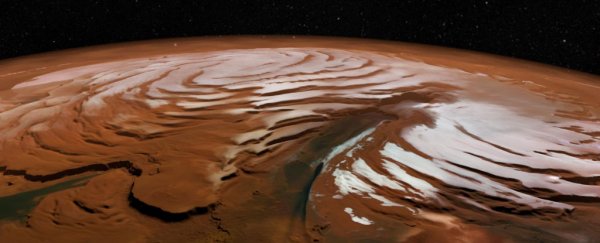Mars may seem to resemble a cold, dusty, and dry landscape, but it looks like the atmosphere can also produce violent, unexpected bouts of snowy weather – particularly after nightfall.
When the Sun goes down and temperatures plunge, Mars experiences intense snowstorms generated by strong gusts of wind, according to a new study that shows there's still a lot we don't know about conditions on the Red Planet.
The findings, led by planetary scientist Aymeric Spiga from the University Pierre and Marie Curie in France, give us a new insight into weather patterns on Mars, which could one day help future explorers colonising the planet.
"It's the first time anyone has shown that snowstorms, or water-ice microbursts, occur presently on Mars," Spiga told Andy Coghlan at New Scientist.
"[W]e used much more sophisticated and fine-scale modelling than done before, allowing us to reinterpret existing measurements that posed mysteries."
Those mysteries sprung from data sourced by NASA's Phoenix lander in 2008, which detected evidence of possible snowfalls in water ice in Martian soil, but which could never be definitively explained.
Now, using Phoenix's readings together with observations from the Mars Global Surveyor and Mars Reconnaissance Orbiter spacecraft, the team calculates that snowfall on Mars doesn't just occur in a slow, gradual process – as had previously been assumed due to the thin Martian atmosphere.
Instead, new weather modelling suggests the Red Planet experiences something much more dramatic: frenetic snowstorms that pelt down small chunks of ice toward the Martian surface.
Triggered by radiative cooling, in which heat would rapidly escape the Martian atmosphere, the team calculates that temperatures in icy Martian clouds would plummet quite quickly, by as much as 4 degrees Celsius per hour.
With hot air rising from the surface combining with colder air masses descending from above, strong winds of up to 10 metres (32.8 feet) per second end up carrying snow downwards suddenly – a phenomenon called microbursts.
These mini blizzards may be intense compared to what scientists previously realised about Martian snowfall, but the actual snow volume output in these localised storms would still be meagre.
"The amount of water overall is quite small – so you won't be able to build any snowmen on Mars with that," Spiga explained to Amina Khan at The Los Angeles Times, "and you won't be able to put up a ski station."
Instead of seeing a thick blanket of snow, the researchers think the downpour would create a generous layer of frost over the Martian surface.
As for why scientists had never discovered these snowstorms before, Spiga suggests it's because his team combined three different kinds of estimations – large-scale climate data, air turbulence models and localised weather predictions – to reveal the phenomenon.
"It's a bit like a Russian doll," planetary scientist Paul Hayne from NASA's Jet Propulsion Laboratory, who wasn't involved with the study, told Nature, "with each successively higher-resolution model fitting inside the other."
If the hypothesis is correct, it means future Mars colonists won't just be encountering snow at the Red Planet's polar ice caps – but in any region where the radiative cooling induces these microbursts – something future missions should keep in mind.
"[T]he associated winds found in the storm are rather vigorous," one of the team, Franck Montmessin from France's Centre National de la Recherche Scientifique, explained to ResearchGate.
"Since they occur in the lower part of the atmosphere, one might want to avoid these turbulent events to ensure a safe landing."
The findings are reported in Nature Geoscience.
